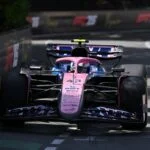Welcome to Madring F1 – Spain’s Next Grand Prix Destination!
Get ready for an electrifying decade of Formula 1 racing as we unveil the stunning new Madring circuit, set to host the Spanish Grand Prix from 2026! This groundbreaking event was officially presented to the public at a grand ceremony on Friday.
A Circuit Rich in History and Excitement
The Madring circuit, steeped in nods to Madrid’s rich history and Spain’s vibrant culture, promises an unforgettable experience for both drivers and spectators alike. With its 5.4-kilometer, 22-turn layout, the circuit is poised to become a fan favorite.
The Madring circuit kicks off with a 589-meter straight, one of the longest in the entire layout. From the starting line, drivers will embark on a thrilling 202-meter sprint to Turn 1, where overtaking opportunities are expected to abound as cars slow down from an astonishing 320 km/h to 100 km/h for the first chicane.
The flat right-hander of Turn 3, known as Curva de Hortaleza, sets the stage for the urban part of the track. After Hortaleza, the circuit curves to the right through Turn 4, with a speed trap of approximately 340km/h as cars slow down for a tight Turn 5-6 chicane underneath a motorway overpass – offering the best overtaking opportunity around the entire lap.
The chicane leads onto the Subida de las Carcavas, an 8% climb named after the neighborhood it runs through. After a blind climb through Turn 7 comes El Bunker, a sharp right-hander adjacent to Spanish Civil War forts of La Mata Espesa. This leads the circuit onto the purpose-built section at the Valdebebas festival grounds, formerly used by the Mad Cool festival.
A fast sweeping downhill section of Turn 10 and Turn 11 gives modern F1 cars more room to flex their muscle. Meet Madring F1’s banked curve, La Monumental – a steep right-hand banking with a semi-circular shape that takes inspiration from Zandvoort’s Luyendyk corner as well as Madrid’s bullfighting arena Las Ventas. The corner features a gradient of 24%, with 550 meters that will be covered in just over five seconds at around 300 km/h. On the outside, a grandstand will be installed to provide views to up to 45,000 spectators.
A third potential overtaking opportunity follows at Turn 13, a slow 84-degree left-hander. It’s the start of another high-speed section called Las Enlazadas de Valdebebas, swooping around football giant Real Madrid’s training complex. After going full throttle through Turns 14, 15 and 16, another hard braking zone follows for the right-hander at Turn 17.
The track passes under the motorway once more to return to the IFEMA fairgrounds that host the paddock. Turn 18 is called Curva Norte because it passes in front of the IFEMA North Convention Centre, which houses hospitality areas. The track then goes into a more typical, twisty street course sector in between the various pavilions down to the final corner of Turn 22, which is named The Park after the adjacent Juan Carlos I Park.
Construction of the Madring is expected to start early next month as organizers aim to get ready for the inaugural edition in September 2026, when Madrid joins Barcelona on the calendar for one year before likely remaining the only Spanish venue on the F1 calendar. Last week, a contract was signed with Spanish construction firm ACCIONA (60%) and France’s Eiffage Construction (40%), who will form a joint venture to construct the 5.47km circuit, easing concerns over the tender process’ slow progress.






